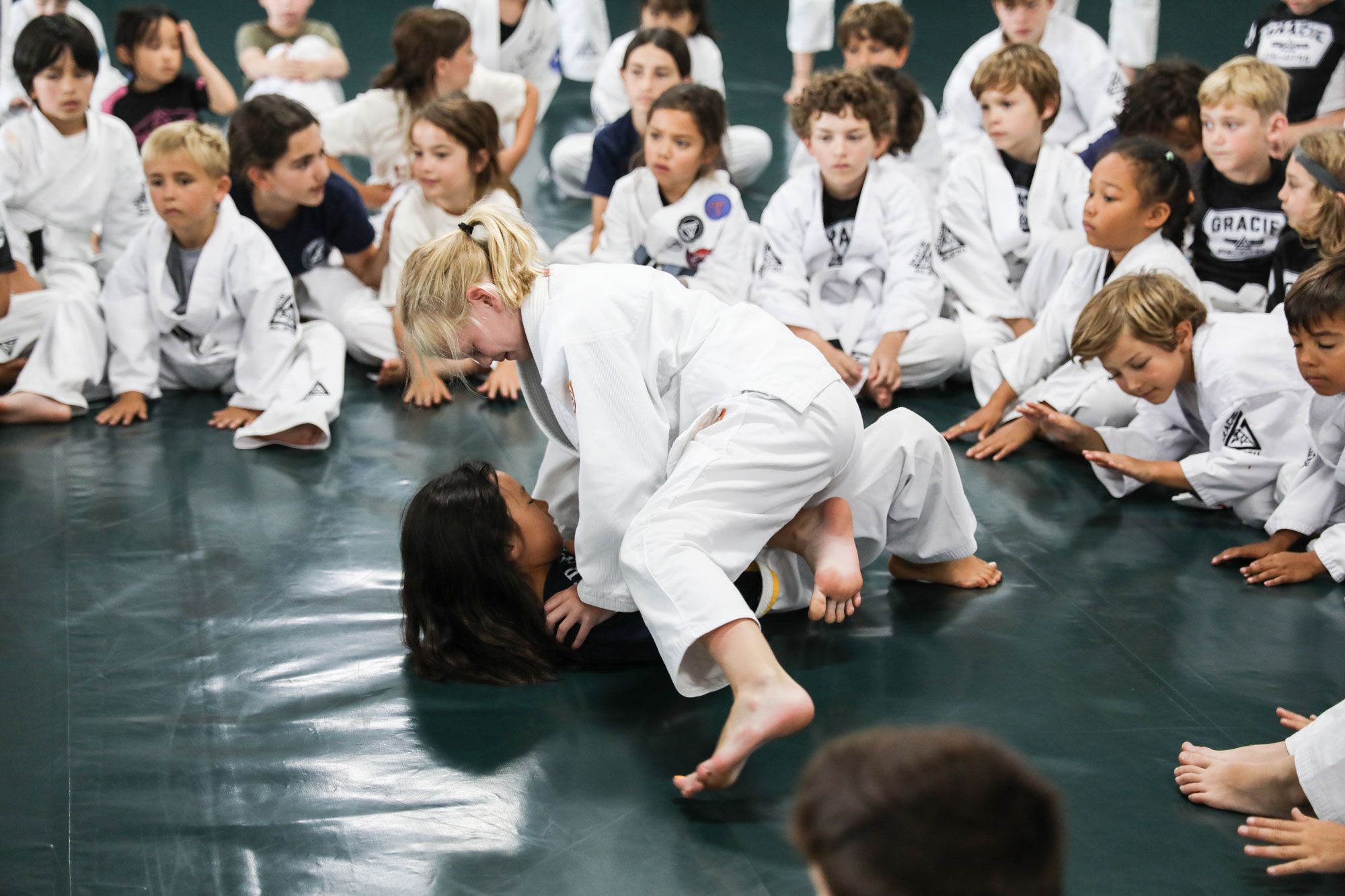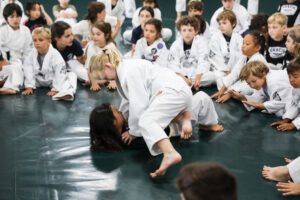Summary: What Are the Gracie Bullyproof Rules of Engagement?
The Gracie Bullyproof Rules of Engagement are a five-step framework that teaches kids how to make confident, responsible decisions when facing bullies. The system helps children know when to walk away, when to speak up, and when to use leverage-based Brazilian Jiu-Jitsu to stay safe without aggression. Developed at Gracie University in Torrance, CA, this roadmap empowers kids with both the mindset and the skill set to handle bullying with composure and control.
Introduction: A Kid-Friendly Framework for Real-Life Bullying
One of the biggest problems with most anti-bullying advice is that it’s too vague for kids to apply.
“Just walk away.”
“Tell a teacher.”
“Use your words.”
All great in theory — but what if the bully doesn’t stop? What if your child is being shoved, grabbed, or humiliated in front of others? What if they freeze?
That’s why we developed the Gracie Bullyproof Rules of Engagement — a simple, step-by-step framework that teaches kids:
- How to stay calm in high-pressure situations
- What to do first, next, and if things escalate
- When it’s appropriate to use verbal vs. physical self-defense
- How to act with confidence and control — not fear or aggression
The Rules of Engagement give children a proven, easy-to-follow system for handling bullies — with firm boundaries, verbal assertiveness, and safe, non-violent self-defense skills.
“We want kids to think before they react. The Rules of Engagement give them that pause — and a plan.”
Why Kids Need a Clear Plan of Action
Bullying is stressful. Even confident kids can freeze if they don’t know what to do in the moment.
The Rules of Engagement help solve this by giving children a clear roadmap — one they can remember and practice until it becomes second nature.
Rather than relying on guesswork or emotion, they follow a structure designed to:
- De-escalate before things get physical
- Involve adults when appropriate
- Keep the child safe if verbal boundaries are crossed
And most importantly, it teaches kids that violence is a last resort — not a first response.
Rule #1: Avoid the Fight at All Costs
The first and most important rule: don’t fight if you don’t have to.
Children are taught that avoidance is always the best first option, whether that means:
- Walking away
- Ignoring the bully
- Involving an adult
But if walking away isn’t possible, the next step is to set a verbal boundary using strong body language and eye contact.
Example boundary:
“Do not ever call me that name again.”
This is not just about words — it’s about presence. Kids are trained to use:
- Eye contact
- Calm, assertive tone
- Confident posture
This verbal boundary acts as a line in the sand. If the bully respects it, the conflict ends without violence. If the boundary is crossed, the child is no longer in Rule #1 — escalation is now appropriate.
This clear structure eliminates uncertainty and panic. The child doesn’t keep repeating boundaries that have already been broken — they move forward with confidence and control.
Rule #2: If Physically Attacked, Defend Yourself
If the bully becomes physically aggressive — pushing, grabbing, or striking — the child is taught to neutralize the threat using non-violent control techniques drawn from Gracie Jiu-Jitsu.
These techniques allow a smaller child to:
- Control the attacker’s movement by managing the distance between them and the bully
- Protect themselves from injury by gaining control positions
- Avoid causing harm by using leverage-based jiu-jitsu instead of punches and kicks
The focus is always defense and control, not punishment or retaliation.
Rule #3: If Verbally Attacked, Use the Three T-Steps (Talk, Tell, Tackle)
Verbal bullying can be just as damaging as physical aggression. The Three T-Steps teach kids a scalable response:
- Talk: Respectfully and confidently ask the bully to stop.
- Tell: If the bully won’t stop, ask a teacher or parent for help.
- Tackle: If adults can’t solve it, tackle the bully mentally with verbal Jiu-Jitsu — and if the bully becomes physically aggressive, defend yourself with Gracie Jiu-Jitsu.
This process gives kids a clear escalation map — from communication to adult involvement to self-protection. They learn that seeking help is smart, not weak, and that self-defense is justified only when safety is threatened.
Rule #4: Never Punch or Kick the Bully — Establish Control and Negotiate
Children are taught to never strike the bully, even when defending themselves. Instead, they learn to use positional control to stay safe, gain stability, and begin verbal negotiation from a secure position.
Example: “Stop moving or I’ll have to hold you tighter.”
This approach teaches empathy, composure, and problem-solving — showing kids that true confidence is calm, not violent.
Rule #5: When Applying a Submission, Use Minimal Force and Negotiate
If the situation escalates to the point where a submission hold (like a joint lock) must be used, children are trained to:
- Use minimal force
- Maintain control without injury
- Attempt to negotiate from a position of safety and control
Example from mount control:
“Are you going to stop? I don’t want to hurt you.”
This teaches:
- Empathy
- Conflict resolution
- Emotional control under pressure
Children are reminded that the goal is not to dominate — it’s to resolve the conflict safely and protect themselves until an adult can intervene.
Accountability and Aftermath
Even when a child follows the Rules of Engagement perfectly, schools often have “zero-tolerance” policies — meaning both kids might end up in the principal’s office.
However, a Bullyproof student can calmly explain exactly what happened:
- They avoided the fight first.
- They set a clear verbal boundary.
- They sought adult help.
- They only defended themselves when attacked.
This clarity helps administrators and parents understand that the child acted with discipline and self-control, not aggression.
Why This System Works
The power of the Rules of Engagement lies in their clarity and repeatability. Kids don’t have to guess or react emotionally — they follow the plan they’ve practiced.
“My son knew exactly what to do. He used Rule #1 first, then set a clear boundary. When the kid didn’t back off, he defended himself calmly and didn’t get in trouble.”
– Jenn D., Parent, Gracie University HQ (Torrance, CA)
This framework removes fear, empowers calm decision-making, and dramatically reduces both overreaction and helplessness.
Want to learn how this system fits into a broader confidence-building approach?
👉 Read: How to Raise a Bullyproof Child →
Try a Gracie Bullyproof Class in Torrance
The Rules of Engagement are taught weekly at our Gracie University Headquarters in Torrance, CA, where kids of all ages learn how to stand up for themselves with confidence and control — no punches necessary.
🗓️ Book your child’s free intro class today →
👉 Click here to reserve your spot
FAQ: Gracie Bullyproof Rules of Engagement
Yes — every Gracie Bullyproof student learns and practices the Rules as part of their foundational training.
Absolutely! In fact, the framework is designed to help shy children build courage and clarity in social situations.
Not in the traditional sense.
We don’t teach children to punch or kick. Instead, they learn leverage-based Brazilian Jiu-Jitsu techniques that allow them to remain safe and maintain control in a physical altercation — without escalating the situation.
The focus is on verbal boundaries first, but if those fail and a bully becomes aggressive, your child will know how to defend themselves using non-violent control — not strikes — to stop the threat without becoming the aggressor.
Yes — and we make it easy. Every Gracie Bullyproof student receives access to our full online video library, which includes all the techniques taught in class, as well as parent resource videos designed to help you support your child’s progress at home.
Final Thoughts: Real Confidence, Real Tools, Real Safety
Bullies thrive on confusion and fear. The Gracie Bullyproof Rules of Engagement give kids the one thing that shuts that down:
A plan.
When children know exactly how to respond — and when — they become calm, clear, and confident in any situation.
That’s what makes them truly bullyproof.
👉 Start your child’s journey at Gracie University in Torrance →


